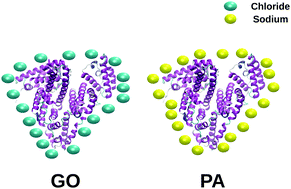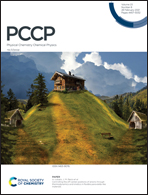Effect of an ionic environment on membrane fouling: a molecular dynamics study†
Abstract
The effect of the ionic environment on membrane fouling was investigated for polyamide (PA) and graphene oxide (GO) membranes using equilibrium molecular dynamics (MD) simulations. For each of these membranes, bovine serum albumin (BSA) was considered as the model foulant. The effect of the foulant on the membranes is investigated at seawater concentration and also in a normal aqueous environment. We investigated the translational and rotational motion of the protein relative to the membrane, interaction energy between the protein and the membrane surface, structural changes in the protein, and ion distribution around the protein and the membrane surface for all the systems. We found that the effects of ions were very different on both the membranes. Specifically, with an increase in ionic strength, the repulsion between the protein and membrane was observed in the case of GO, while for PA, no significant changes were observed for the same. Also, the ion distribution around the protein and the membrane surface were found to be different. In particular, for GO, there were more number of chloride ions around the protein and the membrane than that of sodium ions, which was probably the reason for the repulsion in the case of GO. However, in the case of PA, the membrane surface did not exhibit any affinity towards a specific ion, and the protein in the case of PA was surrounded by more number of sodium ions than chloride ions.



 Please wait while we load your content...
Please wait while we load your content...